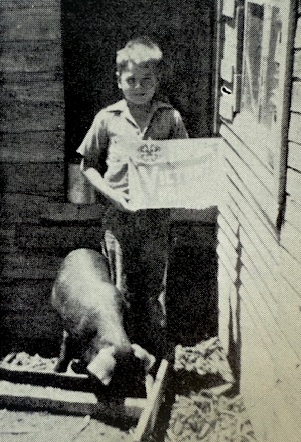Picking a nice juicy, vine-ripened tomato from your home garden can feel like sweet victory, especially to those of us whose green thumbs are a bit challenged. During World War II, home-grown produce was considered an all-out victory for a country facing food rations and possible food shortages. The groundwork of the U.S. Victory Garden program was launched at a National Garden Conference in Washington, DC in December 1941. As part of the war effort, the government rationed foods like sugar, butter, milk, cheese, eggs, coffee, meat and canned goods. Many of those who had been engaged in agriculture were off fighting the war, and transportation systems were needed for hauling soldiers, weapons and supplies; thus, harvesting and moving fruits and vegetables to market became difficult. To avoid a food shortage, the government turned to its citizens and encouraged them to plant Victory Gardens which were also known as war gardens or food gardens for defense.
“Uncle Sam’s wartime food needs have put the all-but-forgotten family vegetable garden back on the map. Millions of Americans are now poring over seed catalogs, checking tools and eyeing likely planting sites,” reported the March 20, 1942 Lakin Independent. “This effort is part of a great national Victory Garden program.”
During the course of World War II, the U.S. Department of Agriculture emphasized that home gardens would reduce pressure on the public food supply and help lower the price of vegetables needed to feed the troops. The money saved could be spent elsewhere on the military. In Kansas alone, a 1942 goal was set for 115,900 gardens compared to the 80,306 gardens planted in 1940. Growing Victory Gardens was a morale booster because Americans on the home front felt that they were helping to win the war. Magazines like Saturday Evening Post and Life wrote about Victory Gardens, and women’s magazines gave instructions on how to grow and preserve homegrown vegetables, fruits and herbs. People with no yards planted small war gardens in window boxes, and rooftop plots sprung up in the cities. Community spaces were also used for Victory Gardens. Even schools got into the act, planting Victory Gardens on their grounds and using the produce in school lunches. In 1944, 18.5 million gardeners took part in Victory Gardens, supplying 40% of the nation’s fresh vegetables, and by the time the war was over in 1945, American Victory gardeners had grown between 8 and 10 million tons of food.
Eleanor Roosevelt played a key role in promoting the Victory Garden movement. The First Lady established a Victory Garden on the White House lawn in 1943 as a patriotic and political message; however, she did not tend to her own garden. Diana Hopkins, the 11-year-old daughter of presidential adviser Harry Hopkins, reportedly cared faithfully for the beans, carrots, tomatoes, and cabbage with a spade, a hoe, and rake.
Youth played crucial roles in contributing to the Victory Garden movement. Many 4-H boys and girls were already involved with helping with the family garden so it was only natural that they would help win the war on the food front. Based on figures collected at the end of 1942, 4-H clubs were responsible for raising three million bushels of garden products, but produce wasn’t their only contribution. They were directly responsible for over 77,000 head of dairy cattle and 246,000 swine. They also answered the call to boost the poultry and egg supply by raising 6.5 million birds.
The concept of Victory Gardens wasn’t new in the United States. In March of 1917, Charles Lathrop Pack organized the National War Garden Commission and launched the war garden campaign during World War I. Food production fell dramatically during the first world war, particularly in Europe. Fertile farmland across the European continent was rapidly disappearing as croplands became barren from drought and were often the scene of battles. Agricultural labor had been recruited into military service, and Europe was running out of food. Pack’s plan, aimed at increasing food production and freeing up resources for the military and Allied forces, resulted in over 5,000,000 gardens in the U.S. Rallying behind President Woodrow Wilson’s cry that “Food will win the war,” American war gardens led to foodstuff production exceeding $1.2 billion by the end of the first world war. After World War I, the movement initially continued with a focus on supporting the stabilization of Europe; however, as commercial food production recovered and Europe began to rebuild, the need for large-scale war gardens declined until they came back into popularity during World War II.
When World War II ended, so did the government promotion of Victory Gardens. Most war gardens disappeared as people became disinterested and wanted to distance themselves from the food hardships of the Great Depression and the war. There was also a significant shift to processed foods, largely driven by factors like economic prosperity, advancements in food processing technology, and the desire for convenience.


SOURCES: The Iman Wiatt Diaries; History of Kearny County Vol. II; National Park Service; Wikipedia; National World War II Museum of New Orleans; 4-hhistorypreservation.com; theworldwar.org; boundarystones.weta.org; Museum archives, and archives of the Lakin Independent and Eureka Herald.
